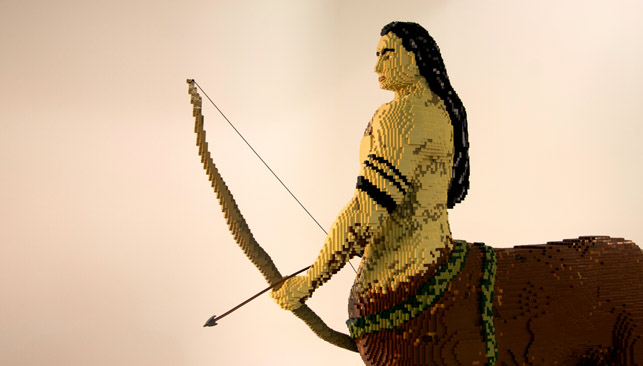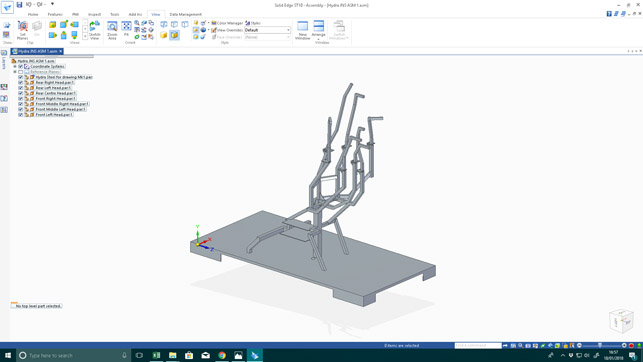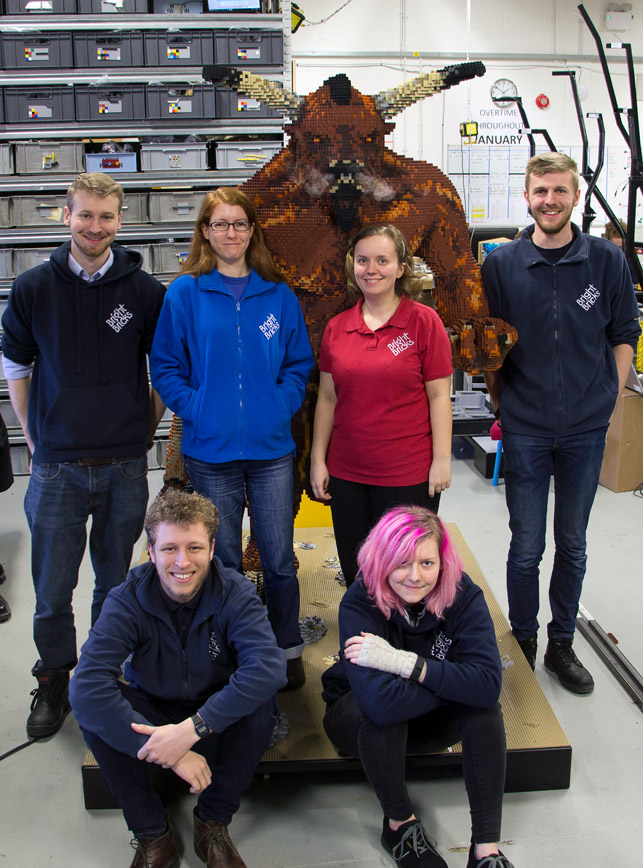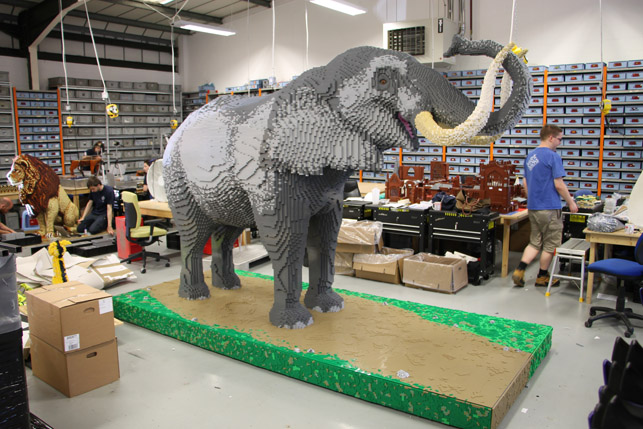
A centaur for Bright bricks’s forthcoming Mythical Beasts Lego tour, which consists of over 50 creatures from mythology
No doubt most of us will remember a box of Lego featuring in our childhood. Hours would be lost to creative play with these plastic interlocking building bricks. And, although the 86-year-old Danish toy company aims its products predominantly at children, many adults build Lego as a hobby (if this is you, you’re officially known as an AFOL or Adult Fan of Lego).
Some even take this hobby to the extreme like Duncan Titmarsh. Having returned from the Royal Air Force at the age of 22, Titmarsh’s passion for Lego was rekindled when he received a set as a gift. He then felt inspired to take down his childhood box of Lego from his parent’s loft and move it to his garden shed where he spent his spare time and money building Lego models.
Although originally building for his own pleasure, as his creations became larger and more impressive, so his reputation grew and soon he was taking commissions.
In 2010 Titmarsh co-founded Bright Bricks and his title of ‘Lego master builder’ was cemented when he became a Lego Certified Professional, the only one in the UK and one of only 16 in the world. This means that although his Lego building company isn’t owned by Lego, it’s recognised as a trusted business partner.

A lion for Bright Bricks’ Great Brick Safari in the process of being built. The hollow models are built around a supportive steel skeleton with two stud wide bricks used inside as bracing against the steel
Bright Bricks – From shed to factory
Fast forward eight years and that garden shed is now a factory, that box of Lego is now 36 million bricks, which are stored in containers from floor to ceiling, and that three person company now consists of 60 members of staff who contribute to the 300 Lego creations that leave the factory doors each year.
These models range in size and complexity. Bright Bricks’ largest model to date is a replica of London Tower Bridge, which was commissioned by Land Rover for the launch of its new Discovery vehicle in 2016. Consisting of over 5.8 million bricks and weighing over 5.5 tonnes, it took 24 builders over three months to construct this 40m long x 40m tall structure.
Most projects the company undertakes are for corporate clients who commission a Lego model for brand promotion whether at a product launch or trade show to engage audiences and enhance product appeal. For instance, McLaren exhibited a life-size McLaren 720S Lego model on its stand at the Goodwood Festival of Speed in 2017, which certainly helped attract a fair share of visitors.
As well as the odd project for an individual private client, Bright Bricks also creates entire interactive Lego brick experiences to be staged at public venues. Its Great Brick Safari, which consisted of 81 models, from a tiny spider through to a full size elephant, went on display at Marwell Zoo in Hampshire from August to October 2017.
Hive of activity
The day that DEVELOP3D visited Bright Bricks in December 2017, the workshop was a hive of activity. “The business has doubled in the past year, it’s mental. We’re slowly taking over the industrial estate,” says Kirsty House, CAD designer and production coordinator.
As well as a few completed builds in the workshop such as a Santa, who was on his way to an event in Liverpool, and a skier who was waiting to be shipped to China, there are also numerous builds in progress. Most notably those for Bright Bricks’ forthcoming Mythical Beasts show, which features over 35 creatures from Greek mythology, and will go on display at Milestones Museum in Basingstoke from 6 February to 15 April 2018.

The steel structure for the 3.2 metre tall seven-headed hydra model was created in Siemens Solid Edge

A view showing what the steel structure will look like inside the Lego bricks

The completed Lego hydra model portrayed in Brickbuilder software
Around each of these models are a few builders who are constructing them one layer at a time by referring to a digital layered view of the model on their laptops.
The hollow models, which predominantly feature a shell that is six to ten Lego studs wide, are built around a supportive steel skeleton that is welded to a base plate. Two stud wide bricks are then used inside as bracing against the steel to prevent the models from warping.
Counting bricks
When House started at Bright Bricks as an intern almost three years ago having recently graduated from Loughborough University in Industrial Design and Technology, she took on the role of designing these steel structures.
Fabricated by a supplier in Southampton, the steel is vital because without it the models, particularly those taller than one metre, would simply topple over.
House’s line manager, who had designed them before her, was creating the engineering drawings by hand. This would involve taking the digital model that the design team had created in Brickbuilder (software specific to Lego that Bright Bricks is allowed to use with Titmarsh being a Lego certified professional) and then counting the individual Lego bricks to accurately determine where the steel structure needed to go. With every part of the steel being drawn manually, this process would take tup to three weeks.
“You needed a magnifying glass to count these tiny weeny squares. It really gave you a headache,” confesses House.
“And then there’d be instances when the steel wasn’t quite right and meant that we’d have to get the angle grinder out to shave a corner off . Or, the other option, is having a model that has unexpectedly developed an abscess,” she smiles.
Having used CAD at university, House knew there had to be an easier way to go about drawing the steel but fi nding the right software proved somewhat challenging.
“I did pretty much look at every CAD software that exists but trying to explain what we needed it to do proved very difficult,” she confesses.
“However, Siemens said there was a solution in the future that could potentially help and so we started working together in March 2017.”
This solution was Solid Edge ST 10, which features the newly developed convergent modelling method. This method enables users to seamlessly import data, particularly those geometries composed of a combination of facets, planes and solids, into Solid Edge. Here this data can be converted into a solid and used as a reference to enable further operations to be performed on the model such as adding new features, like a steel skeleton.

The design team in front of the minotaur, which has been created for the Mythical Beasts show
Bright Bricks – Kicking off the design process
Of course, the design of the steel structure comes after the actual Lego model has been completed by the design team. So at the start of a project and depending on what is being created, the designers will source a 3D image file. At the time of visiting the design team were creating creatures for its Mythical Beasts show.
“The Minotaur I’m currently working on started out as a few 3D modelling assets found online, for instance the head was just a generic cow’s head with horns added. We’ll also sometimes get more complete 3D files from sites such as TurboSquid,” explains Bryn Morgan, design team leader. “We’ll then sculpt over the model using a digital sculpting tool like ZBrush or Blender to create the high-resolution models.”
From here the model is brought into Brickbuilder, which essentially converts the mesh into Lego bricks.
“The next step after the pose is confirmed is to hollow out the digital Lego brick model via a function in Brickbuilder leaving only a two stud wide shell.”
The completed Lego model is then converted into an STL file. House or her colleague Jordan Griffith will import this STL into Solid Edge, which provides a representation of the Lego model.

A completed life-size, 1.5 tonne elephant for the Great Brick Safari show
They then use the Live Section command in the software to insert planes through the model in certain places. From here slices are created that are then used as reference to draw the steel structure inside. “From these sliced section curves we can work up through the model making sure that the steel stays inside the Lego,” describes Griffith.
The use of Solid Edge over manually drawing the steel structure has not only enabled accuracy but also drastically reduced the design process as the drawings for the steel can now be completed in days rather than weeks.
This accuracy has also enabled the design team to up their game in terms of creating more complicated Lego models. For instance, in the Mythical Beasts range there is a seven headed hydra that stands 3.2 metres tall.
“There were 38 pages of steel drawings for the hydra. I had to do eight separate structures and make sure that they were strong enough to hold the layers. There was a lot to think about and I spent 57 hours on it. I’d be quite glad to see it finished,” laughs Griffiths.
House adds, “We would never have been able to do the hydra before the use of Solid Edge. Not with counting squares.”
Then, once the design of the steel structure is complete, it’s brought into Brickbuilder as its own separate mesh. The design team will then subtract it from the 3D Lego model creating, what Morgan describes as, cladded pillars. This means that the builders in the workshop, when looking at the model on their laptops, which is separated layer by layer, can see exactly where these pillars are. They can then fit a brace between it and the internal skin of the model to minimise the amount of bricks used whilst still ensuring the model will be structurally sound.
However, before the digital 3D model is sent to the builders’ laptops, the designers need to paint each of the Lego bricks. Interestingly, the colour palette is pretty limited with only 32 colours to choose from. This often calls for a bit of creativity, such as speckling to get the right shade.
“We also have a few colour grades such as the natural fur colours that were used a lot in our Safari range. We then try to blend them in various ways so they look different,” explains Morgan.

Another creature from mythology for Mythical Beasts. This one is a hippogriff
Piece of the art
The whole process from the design of the Lego model and steel structure through to the fabrication of the steel and the actual build of the Lego model in the workshop takes a fair bit of time. Especially as only a limited number of builders can work on a model at any one time because you simply can’t fit more people around it.
Despite the time it takes and the expense (understandably, these models don’t come cheap) the demand is higher than ever. But, arguably, they are a piece of art and Bright Bricks continually strives to be ever more creative and imaginative in what it produces. Pretty impressive for something that started with a box of Lego in a garden shed.






